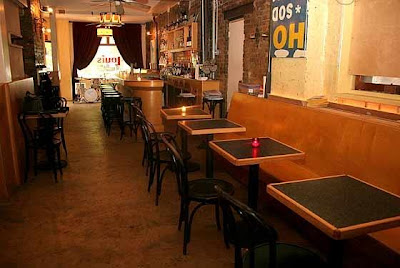Here's the piece I wrote for the New York Times' Diner's Journal yesterday. Below find the entire seminar schedule. Curacao, eh? I guess I don't known as much as Curacao as I ought to. (The ones with asterisks are repeats of seminars from last fall. I recommend Petraske's.)
Seminars for Astor Center
The Big Orange: Curacao & The Cocktail Steve Olson, Dave Wondrich
Glasses & Tools: How Do You Choose the Right Glass for a Drink?* Dale DeGroff
Ultimate Beverage Challenge WinnersPaul Pacult & the team
Cocktail Royalty: The Martini FamilyAngus Winchester
Cocktails for the Home Cocktail Party*Sasha Petraske
Mastering the Art of Bartending: Everything You Need to Know Before Even Picking Up a BottleGary Regan, Dushan Zaric, Simon Ford, TJ Lynch, and Aisha Sharpe
From the Farm to the Glass: Sustainable Farming and Organic Spirits and CocktailsMelina Shannon-DiPietro, Yale Sustainable Food Project
Joseph Magliocco, Crop Harvest Earth Organic Vodkas
Allen Katz, Southern Wine & Spirits
Preserving with Liquor for Killer-Cocktails All Year Round: Twelve Months of Local Ingredients Behind The Bar Francis Schott & Mark Pascal, Mixologists, Bar Owners & Hosts of The Restaurant Guys Radio Program
The Sherry Cocktail*Andy Seymour
Wood for Thought: Playing Master Blender with Single Malt Scotch Whisky Sam Simmons, The Balvenie Ambassador USA (East)
When It‘s Cocktail Time in Cuba Phil Greene and Charlotte Voisey
What Does it Take to Win a Cocktail Competition? Gary (Gaz) Regan
Spice: The Fennel Frontier Tad Carducci, Tippling Bros.
Spirits and Agriculture TBD
American Drinks Invade Europe Dave Wondrich, Fernando Castellon, other panelists
Gin's of England Desmond Payne (Master Distiller, Beefeater Gin) & Sean Harrison (Master Distillery, Plymouth Gin)
The Harry Johnson StoryAnistatia Miller & Jared Brown
Famous Hotel Bars and Men and Women Behind Them Elayne Duke, Mixologist and Spirits Ambassador for Diageo, and other special guests
Booze Biz 2.0 – Beyond Slinging Drinks Moderator: Francine Cohen – Editor in Chief, Inside F&B
Panelists:
Jason Littrell – Death & Company, Louis 649, Cain Luxe
Gianfranco Verga – Manager, Louis 649
Dushan Zaric – Employees Only, Macao Trading Company
Additional industry professionals to be announced
Chasing the White Dog in Manhattan Junior Johnson (Legendary Moonshiner), Joe Michalek (Founder of Piedmont Distillers) and Max Watman (Author of “Chasing the White Dog: An Amateur Outlaw's Adventures in Moonshine”)
Drink Punch and Be MerryDave Wondrich
Complex Cocktails for Busy Bars moderated by Cheers editor-in-chief Liza Zimmerman
Distillation for Flavor – Past, Present and Future Merlin Griffiths, Gin Expert
Bar Myth Busters Don Lee & Alex Day
The Spirited Whey: Monk-Inspired Cocktails and Cheeses Diana Pittet & Kara Newman
And How Many Bubbles Would You Like in that Cocktail? Dale DeGroff & Doug Frost
The Agave Session: The Magical Elixirs of Mexico* Steve Olson
Bartenders, Bloggers, and Brands Lindsey Johnson, Jason Littrell, TBD Bloggers
Seminars for Astor Center
The Big Orange: Curacao & The Cocktail Steve Olson, Dave Wondrich
Glasses & Tools: How Do You Choose the Right Glass for a Drink?* Dale DeGroff
Ultimate Beverage Challenge WinnersPaul Pacult & the team
Cocktail Royalty: The Martini FamilyAngus Winchester
Cocktails for the Home Cocktail Party*Sasha Petraske
Mastering the Art of Bartending: Everything You Need to Know Before Even Picking Up a BottleGary Regan, Dushan Zaric, Simon Ford, TJ Lynch, and Aisha Sharpe
From the Farm to the Glass: Sustainable Farming and Organic Spirits and CocktailsMelina Shannon-DiPietro, Yale Sustainable Food Project
Joseph Magliocco, Crop Harvest Earth Organic Vodkas
Allen Katz, Southern Wine & Spirits
Preserving with Liquor for Killer-Cocktails All Year Round: Twelve Months of Local Ingredients Behind The Bar Francis Schott & Mark Pascal, Mixologists, Bar Owners & Hosts of The Restaurant Guys Radio Program
The Sherry Cocktail*Andy Seymour
Wood for Thought: Playing Master Blender with Single Malt Scotch Whisky Sam Simmons, The Balvenie Ambassador USA (East)
When It‘s Cocktail Time in Cuba Phil Greene and Charlotte Voisey
What Does it Take to Win a Cocktail Competition? Gary (Gaz) Regan
Spice: The Fennel Frontier Tad Carducci, Tippling Bros.
Spirits and Agriculture TBD
American Drinks Invade Europe Dave Wondrich, Fernando Castellon, other panelists
Gin's of England Desmond Payne (Master Distiller, Beefeater Gin) & Sean Harrison (Master Distillery, Plymouth Gin)
The Harry Johnson StoryAnistatia Miller & Jared Brown
Famous Hotel Bars and Men and Women Behind Them Elayne Duke, Mixologist and Spirits Ambassador for Diageo, and other special guests
Booze Biz 2.0 – Beyond Slinging Drinks Moderator: Francine Cohen – Editor in Chief, Inside F&B
Panelists:
Jason Littrell – Death & Company, Louis 649, Cain Luxe
Gianfranco Verga – Manager, Louis 649
Dushan Zaric – Employees Only, Macao Trading Company
Additional industry professionals to be announced
Chasing the White Dog in Manhattan Junior Johnson (Legendary Moonshiner), Joe Michalek (Founder of Piedmont Distillers) and Max Watman (Author of “Chasing the White Dog: An Amateur Outlaw's Adventures in Moonshine”)
Drink Punch and Be MerryDave Wondrich
Complex Cocktails for Busy Bars moderated by Cheers editor-in-chief Liza Zimmerman
Distillation for Flavor – Past, Present and Future Merlin Griffiths, Gin Expert
Bar Myth Busters Don Lee & Alex Day
The Spirited Whey: Monk-Inspired Cocktails and Cheeses Diana Pittet & Kara Newman
And How Many Bubbles Would You Like in that Cocktail? Dale DeGroff & Doug Frost
The Agave Session: The Magical Elixirs of Mexico* Steve Olson
Bartenders, Bloggers, and Brands Lindsey Johnson, Jason Littrell, TBD Bloggers









































